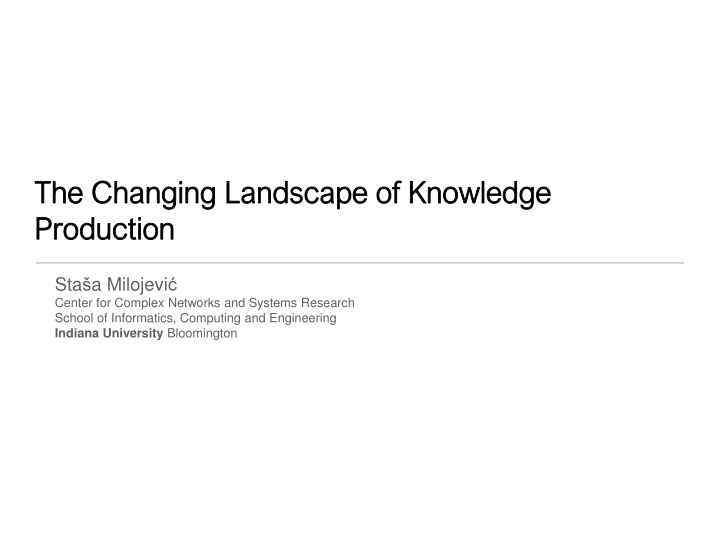
Changing Landscape of Knowledge Production and Growth in Science
Explore the evolving landscape of knowledge production in science, characterized by larger practitioner numbers, productivity pressures, and interdisciplinary approaches. Witness the exponential growth of scientific literature and delve into big data methods for measuring cognitive extent. Insights from notable studies shed light on the dynamics shaping the realm of knowledge creation.
Download Presentation

Please find below an Image/Link to download the presentation.
The content on the website is provided AS IS for your information and personal use only. It may not be sold, licensed, or shared on other websites without obtaining consent from the author. If you encounter any issues during the download, it is possible that the publisher has removed the file from their server.
You are allowed to download the files provided on this website for personal or commercial use, subject to the condition that they are used lawfully. All files are the property of their respective owners.
The content on the website is provided AS IS for your information and personal use only. It may not be sold, licensed, or shared on other websites without obtaining consent from the author.
E N D
Presentation Transcript
The Changing Landscape of Knowledge The Changing Landscape of Knowledge Production Production Sta a Milojevi Center for Complex Networks and Systems Research School of Informatics, Computing and Engineering Indiana University Bloomington
Changing landscape of knowledge production Science has experienced dramatic changes in knowledge production exemplified by: -larger number of practitioners -increased pressures on productivity -shift toward team science -interdisciplinarity
Growth of publications 1.5 Annual number of papers [millions] Entire Web of Science Production of scientific litrature Td= 24 yr 1 Td= 13 yr Td= 9 yr 0.5 Td= 26 yr WoS articles Piecewise exponential 0 1890 1900 1910 1920 1930 1940 1950 Publication year 1960 1970 1980 1990 2000 2010 2020
Exponential growth of scientific literature = Exponential growth of knowledge?
Exponential growth of scientific literature Exponential growth of knowledge =
Big-data method for measuring the cognitive extent of scientific literature Obtain concepts from parsing titles into phrases Idea: count the number of unique phrases in unit quotas of ~3000 articles 3000 articles which contain fewer unique phrases (X) have a smaller cognitive content than 3000 articles with more unique phrases (Y) Large measurement quota is needed to reduce the stochasticity of the titles Milojevi , S. (2015). Journal of Informetrics 9, 962
Growth of Science 1.5 Annual number of papers [106] A 1.0 WoS articles 0.5 Exponential fit 0.0 1900 1920 1940 1960 1980 2000 2020 Publication year 40 Unique article title phrases [103] B 35 Cognitive extent 30 WoS articles 25 Linear fit 20 1900 1920 1940 1960 1980 2000 2020 Publication year Fortunato, S., Bergstrom, C. T., B rner, K., Evans, J. A., Helbing, D., Milojevi , S Radicchi, F., Sinatra, R., Uzzi, B., Vespignani, A., Waltman, L., Wang, D., & Barab si, A-L. (2018). Science, 359(6379). Milojevi , S., Petersen, A. M.,
Operationalizing Interdisciplinarity We develop a measure of knowledge interdisciplinarity: the extent to which the field/author/paper draws on knowledge from distinct fields. Determine, for each WoS paper, its main area + contributions from other broad fields. Based on the analysis of references. Interdisciplinarity = % of references from other fields Milojevi , S., Radicchi, F., & Walsh, J. P. (in preparation)
Level of interdisciplinarity in 13 broad fields Milojevi , S., Radicchi, F., & Walsh, J. P. (in preparation)
Distribution of interdisciplinarity levels in 13 broad fields Milojevi , S., Radicchi, F., & Walsh, J. P. (in preparation)
Changes in interdisciplinarity over time Entire WoS Milojevi , S., Radicchi, F., & Walsh, J. P. (in preparation)
Changes in interdisciplinarity over time Since 1960 Milojevi , S., Radicchi, F., & Walsh, J. P. (in preparation)
Team size distribution and its evolution Many studies focused only on the mean or the median sizes of teams, implicitly assuming that the character of the distribution of team sizes does not change When distributions were looked into, the focus was only on power-law tails of large teams in recent times
Modern science: the rise of collaboration The increasing level of knowledge production by large science teams 1960s: Individual authors (90%) and small teams Astronomy 2000s: Individual authors (<10%) Mean team size ~7 Previously only high-energy physics and biomedical; now most experimental fields have a Big Science component Poisson distribution Tail of power-law distribution
Change in the character of team size distribution Astronomy Team formation essentially a Poisson process process, which somehow transformed Poisson Milojevi Milojevi , S. , S. (2014). PNAS, 111(11), 3984
Team sizes across disciplines LINES = three- component functional fits 1E+1 Ecology Mathematics Social psychology arXiv Astronomy (fit) arXiv 1E+0 1E-1 (physics) Astronomy, arXiv (physics) prominent power-law tail 1E-2 Articles 1E-3 1E-4 Ecology, psychology weaker power-law tail 1E-5 1E-6 2006-10 Mathematics no power-law tail 1E-7 1 10 Article team size (k) 100 Milojevi Milojevi , S. , S. (2014). PNAS, 111(11), 3984
Model: Two (three) types of research teams Contribution of team types according to the model: Small core teams based on Poisson process In recent times there is an excess of two- author papers over single-author papers, especially from authors who have just started publishing. Requires slightly modified Poisson distribution Large, extended teams that grow gradually on the principle of cumulative advantage based on productivity 1E+0 1 ALL TEAMS Standard core teams Core +1 teams Extended teams 1E-1 0.1 1E-2 0.01 Articles 1E-3 10-3 1E-4 10-4 1E-5 10-5 2006-10 1E-6 10-6 1E-7 10-7 1 10 Article team size (k) 100 Milojevi , S. Milojevi , S. (2014). PNAS, 111(11), 3984
Trends in team sizes and types in the last 50 years Apply functional decomposition to five-year periods in astronomy to get contributions by different team types 7 12 1 7 12 1 Astronomy Astronomy Astronomy Astronomy Astronomy Astronomy 6 0.9 0.9 Fraction of articles produced by: Fraction of articles produced by: 6 10 10 0.8 0.8 5 0.7 Standard core teams 5 Mean team size Parameter value 0.7 Standard core teams 8 Mean team size Parameter value 8 0.6 0.6 4 4 6 0.5 6 0.5 3 Extended teams 0.4 3 Extended teams 0.4 4 4 0.3 2 0.3 2 Rate of Poisson w/extra member Rate of Poisson w/extra member 0.2 2 0.2 "Core +1" teams Core teams 1 2 "Core +1" teams Core teams 1 0.1 0.1 0 0 0 0 0 0 1960 1970 1980 1990 2000 2010 1960 1970 1980 1990 2000 2010 1960 1970 1980 1990 2000 2010 1960 1970 1980 1990 2000 2010 1960 1970 1980 1990 2000 2010 1960 1970 1980 1990 2000 2010 Year Year Year Year Year Year Fraction of papers due to extended teams nearly constant. It is the extended teams that drive the exponential growth of average team size. Team science is not a new thing, but only recently extended teams got conspicuously large. Core teams grow, but only linearly (changing norms of how many people are needed to do standard science?) Core teams remain the main production mode! Milojevi , S. Milojevi , S. (2014). PNAS, 111(11), 3984
Different team types correspond to different modes of knowledge production Core teams dominate 1E+0 1 ALL TEAMS Standard core teams Core +1 teams Extended teams 1E-1 0.1 1E-2 0.01 Articles 1E-3 10-3 1E-4 10-4 1E-5 10-5 Extended teams dominate 2006-10 1E-6 10-6 1E-7 10-7 1 10 Article team size (k) 100 Milojevi , S. Milojevi , S. (2014). PNAS, 111(11), 3984
Trends in team sizes and types in the last 50 years case of non-collaborative field 4.0 4.0 1.2 1.2 1 1 Mathematics Mathematics Mathematics Mathematics Mathematics Mathematics 0.9 0.9 Fraction of articles produced by: Fraction of articles produced by: 3.5 3.5 1 1 0.8 0.8 3.0 3.0 0.7 0.7 0.8 Extended teams Extended teams Parameter value Parameter value Mean team size Mean team size 0.8 2.5 2.5 0.6 0.6 2.0 2.0 0.6 0.6 0.5 0.5 0.4 0.4 1.5 1.5 0.4 0.4 0.3 0.3 1.0 1.0 0.2 0.2 Extended teams Extended teams 0.2 0.2 0.5 0.5 0.1 0.1 0.0 0.0 0 0 0 0 1960 1970 1980 1990 2000 2010 1960 1970 1980 1990 2000 2010 1960 1970 1980 1990 2000 2010 1960 1970 1980 1990 2000 2010 1960 1970 1980 1990 2000 2010 1960 1970 1980 1990 2000 2010 Year Year Year Year Year Year Extended component has very small contribution and such teams are barely larger than core teams Milojevi , S. Milojevi , S. (2014). PNAS, 111(11), 3984
Is the only role of small teams to seed big ones? Which approach contributes more to modern science intellectually? Are the efforts of smaller teams becoming intellectually obsolete?
Evolution of the cognitive extents by teams of different sizes Milojevi , S. (2015). Journal of Informetrics 9, 962
Inverse correlation between research team size and the cognitive extent of scientific output 2005-2010 Milojevi , S. (2015). Journal of Informetrics 9, 962 In physics and astronomy, single authors, pairs of authors, and small teams cover the largest intellectual territory, the same size as the entire field. Larger teams cover significantly smaller cognitive territory. In biomedicine, the small teams (3-5 authors) cover the largest domain, but as in astronomy and physics, the very large teams cover the smallest cognitive territory. Plus: Topics covered by large teams are not exclusive to them
Interdisciplinarity and team sizes interdisciplinarity of teams vs. that of single authors Milojevi , S., Radicchi, F., & Walsh, J. P. (in preparation)
How does the shifting landscape of science over the past half century affect the roles of researchers and their overall careers?
Scientific careers through an organizational studies lens - Larger team sizes followed by the increased division of labor and standardization are bringing fundamental changes to scientific work and therefore the scientific workforce - Transition from the science organization based on craft to the one based on bureaucratic industrial principles (Hagstrom, 1964; Hargens, 1975; Walsh & Lee, 2015) - The tensions between the research production and teaching functions that academic labs provide (e.g., Hackett, 1990; Hagstrom, 1964; Pavlidis et al., 2014; Stephan, 2012; Teitelbaum, 2014).
The rise of supporting scientists or permanent team members The fraction of authors who never become a lead author has risen dramatically 0.8 Astronomy 0.7 Ecology 0.6 Robotics Fraction of cohort 0.5 0.4 0.3 0.2 Authors who never become lead authors 0.1 0 1950 1960 1970 Year entered field (cohort year) 1980 1990 2000 2010 2020 Adapted from Milojevi , S., Radicchi, F., & Walsh, J. P. (2018). PNAS, 111(50), 12616-12623.
The rise of supporting scientists or permanent team members and this is not the result of the increase in the number of transient (single- publication) authors still around 1/2 today 0.6 Astronomy Ecology 0.5 Robotics Transients excluded from cohorts Fraction of cohort 0.4 w/o transients 0.3 0.2 Authors who never become lead authors 0.1 0 1950 1960 1970 Year entered field (cohort year) 1980 1990 2000 2010 2020 Adapted from Milojevi , S., Radicchi, F., & Walsh, J. P. (2018). PNAS, 111(50), 12616-12623.
Milojevi, S., Radicchi, F., & Walsh, J. P. (2018). PNAS, 111(50), 12616-12623.
Thank you! Sta a Milojevi Center for Complex Networks and Systems Research School of Informatics, Computing, and Engineering Indiana University Bloomington smilojev@indiana.edu Parts of this work were supported by National Science Foundation grant EAGER SMA-1645585. This work uses Web of Science data by Clarivate Analytics provided by the Indiana University Network Science Institute and the Cyberinfrastructure for Network Science Center at Indiana University.

